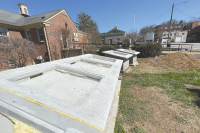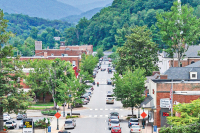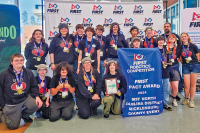HCC unveils new Professional Arts and Crafts center
 With her hands fluttering like a hummingbird, Dana Claire loops skeins of colored yarn around a large pegboard.
With her hands fluttering like a hummingbird, Dana Claire loops skeins of colored yarn around a large pegboard.
Claire has been interested in fiber crafts her entire life and now, in her retirement years, has she decided to pursue her true passion of working with her hands by going back to school. Offering a nationally recognized professional crafts program, she found herself at Haywood Community College in Clyde. This semester, she’s learning and engaging in the new Creative Arts facility constructed on campus.
“What I’m interested in is creating new textiles that tell a story, that fascinate people and are one-of-a-kind pieces,” she said.
Though she was originally attracted to HCC for its storied reputation, she was somewhat turned off when she saw the old arts and crafts building. It was small, cramped and rundown — a place she couldn’t imagine spending two years full-time studying in.
She wrote off coming to the campus, but that soon changed when she found out the new arts and crafts facility was slated to open. She immediately enrolled and began taking classes last fall.
Related Items
“If you’re drawn to textiles, or any of these mediums here, this the most fabulous experience in learning and using those things to be creative and productive,” she said.
An enormous 38,000 square foot structure, the new building has been years in the making. It opened last month, welcoming more than 60 full-time arts and crafts students into the eco-friendly, state-of-the-art facility where creativity can properly flourish in a purpose-built space — specifically designed with the professional crafter in mind.
“I’ve been looking at the plans for this place so much, for so long, that finally seeing it in three-dimensional form is quite stunning,” said Terry Gess, chair of professional crafts at HCC.
To Gess, it’s important the HCC crafts program now has a modern facility to match the already stellar reputation of the program.
“I’ve worked here five years and the whole time we’ve been planning and designing this,” Gess said. “It has been a long-held dream to have a creative arts center at HCC. There were a lot of capable individuals behind this that made it happen.”
Breaking ground
For more than 30 years, the professional crafts program at HCC has been a mainstay in the creative and business climate of crafts in Western North Carolina. A key component in the survival and perpetual interest in clay, fiber, jewelry and wood arts, the school and its instructors attracted talented and determined students from around the country.
“The program here teaches you to learn how to be an artist, and also learn how to be able to make a living at it,” said Kari Rinn, continuing education creative arts coordinator at HCC.
Rinn points to the different aspects the school has to offer. Besides the hands-on programs, students also learn key marketing and design tools to better themselves at survival in a sometimes harsh business world for artists. Alongside the art majors, there are dozens of continuing education students, with enrollment aimed to increase on both sides of the equation as a bigger space means the possibility of more classes and amenities offered.
“I’m excited about the potential this building holds,” Rinn said. “It will build these programs and bring a lot of attention to them. We’re going to do all we can to grow and offer as much as we can to the community and beyond.”
Clay instructor Steven Lloyd notes how HCC was one of the first craft programs nationally to offer marketing and business into its curriculum. For him, it’s about providing students with the proper skills to stand on their own after graduation.
“With this program, we take students from the very beginning, often with no experience, and teach them how to fire, glaze, make pots, and also how to go out there and market their work,” he said.
And as the program’s notoriety skyrocketed, the physical stability of the old building itself plummeted. A mindset of “if you build it, they will come” started seeping into the minds of the administration. They had the pupils to inspire, and the right people to nurture those eager students, but at some point the comfort of one’s surroundings start to become a large factor in deciding where to learn and grow.
It was time for change.
With a $10.2 million dollar price tag, the project was controversial in the beginning stages. Money for the new building would come from a dedicated pot set aside for the HCC campus —namely from a quarter-cent sales tax that was approved by voters several years ago with the express purpose of college improvement projects.
The school and the Haywood County Board of Commissioners soon found themselves in a constant tug-of-war with each other, however. Commissioners saw the price tag as too high, the building too fancy and disagreed with some of the “green” design features.
But administrators pushed back with their reasoning over the basic cost of the project, and why the college would be smart to invest in a state-of-the-art facility to house its storied arts and crafts program.
Observing the students busy at work, Gess still can’t believe all of the hard work to get to this point has finally paid off. The building is now a reality, with a promising future already unfolding into the next phase for the institution. Now, it’s a matter of getting the word out that Haywood Community College has a facility that can backup its renowned history.
“This is an exciting time in Haywood County,” he said. “We’re looking forward to taking craft to another level.”
Welcome home
The architectural design is built in harmony with the natural contour of a hillside on campus, flowing down the slope like a waterfall. As you enter on the top floor, a large staircase cascades three levels, with an array of hallways, classrooms, workshops and keenly placed nooks branching off.
Designed for comfort as much as creativity, the space is made for the individual, where every little detail is aimed at provoking curiosity within each student’s respective major.
“It’s a dream come true,” said jewelry instructor Robert Blanton. “This is going to open the way for us. There’s a lot more possibilities for the students here. The environment, natural light and space are much better than the old building.”
Though it may have become obsolete, the original building had gained character and history from all of those talented crafters who passed through its halls.
“Going back to the old building, the life is gone out of it, it’s oddly quiet, and that’s because we brought the life with us over here,” Blanton said. “We haven’t started making this space ours yet, but it will find its identity.”
Bridging the future
Each of the four craft concentrations — the mediums of wood, fiber, clay and jewelry — have their own elaborate workshops, and each student in the program has their own dedicated workstation.
Blanton said all the newfound room is a little overwhelming, with a lot of unpacking left to do, but it’s all part of the process of transitioning that accompanied the opening of the new building.
“The history of this program proves people came here not because of the facilities, but for the instructors, atmosphere and environment,” he said. “Now we can equal that history with this new building. It definitely sets us on a different level.”
An educator at the school for the last 11 years, Blanton has seen his share of changes in the program. It’s been a long road, but a bountiful one that is coming into its next stage.
Now, students sit at their own workstation, with the ideal amount of space and tools allotted to work efficiently. Being able to offer students a top-of-the-line program will ultimately influence the quality and productivity of their work.
“Their ability to work in here will be much more conducive to wanting to work and wanting to be in the studio,” he said.
Downstairs in the domain of woodworking, the constant sounds of buzzsaws, hammers, drills and other intricate machines echo throughout the bottom floor. Several students mill about, moving around in what could only be described as organized chaos. It’s an impressive sight, one that accurately shows the promise and efficiency of each pupil.
“It’s marvelous here,” said wood instructor Brian Wurst. “This offers a chance for new equipment, increased enrollment, better guests for demonstrations and adequate space for bigger, more complicated projects.”
At a nearby table, second-year wood student Brandon Skupski is excited about the new facility. He likes the fact he was able to spend his first year in the old building and this year in the new center. Skupski is proud to be a part of the professional craft program. It’s a lot of hard work, but something he knows will be worth it in the long run.
“This is a workshop most woodworkers would dream of, and we’re taking full advantage of what we have here,” he said. “It’s a great opportunity for me and hopefully lots of people in the future.”
Back upstairs, Lloyd is hard at work setting up his clay studio and readying the final touches of the classroom. Natural light filters through the windows and trickles down onto a handful of students at their wheels, each intensely focused on the project at hand.
Walking out onto the back patio, Lloyd points to the handful of kilns that are currently being constructed by the students.
In HCC’s professional crafts program, students not only learn to create and market artwork, but also to properly build and fire their own kiln.
“The old place had a lot of character that it built up for years,” he said. “And this place will take some time to get settled in and comfortable, but the students already love the space.”
Walking around her classroom on the third floor, fiber instructor Amy Putansu sees productivity and organization as she watches her students create. She doesn’t miss the old building and is amazed at how much they actually were able to get done in such a tiny abode.
“I think we may be spoiled already,” she chuckled. “But, this much space is really what we needed. There are a lot of different techniques and practices done here, and it’s hard to describe the difference coming from the old space to here.”
Besides sinply having enough room for the numerous space-consuming looms, the fiber floor houses all of the textile techniques and practices, which include sewing, dying, weaving and hand stitching. Every practice required and received a different type of space, and Putansu sees it as beneficial for the students.
“Contemporary fiber arts are multi-process textiles,” she said. “Being able to offer all of these things to the students makes them that much more prepared when they graduate to put it all together.”
Sustaining creativity
Besides the picturesque art that will soon adorn building, there is just as much creativity and beauty behind the walls, underneath the floor and on top of the roof. A long list of green and sustainable technologies have been installed to provide the structure with renewable energy. A focus on sustainability in recent years has put HCC in the upper echelon of academic institutions promoting and incorporating these practices into their philosophy.
“This kind of technology is really in its infancy, and we’re breaking a lot of ground with this building,” said Bill Dechant, director of campus development.
The building incorporates three renewable technologies, which includes solar thermal for hot water and heat, solar thermal for air conditioning, and solar panels for electricity. The sun warms water flowing through coils on the roof, which in turn provides hot water and heats the building as it runs through pipes below the floor. The heat is also used to run an absorption chiller that powers cool air to flow through ceiling vents.
The roof houses a rainwater collection system that goes into a 35,000-gallon tank, which is utilized to flush all of the toilets in the building and provide water for the cooling towers on the outside. The building also uses natural gas for certain aspects of the facility (like the clay kiln), as well as a backup system for the solar panels on cloudy days.
“For the college, this is a great marketing tool, especially for the students we teach green technology to here,” Dechant said. “What we’re going to find is that this building is going to bring us a lot of attention.”









